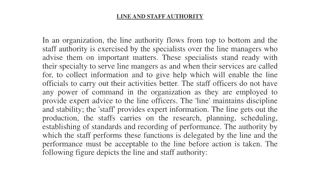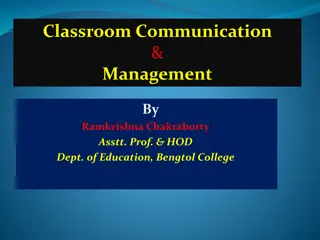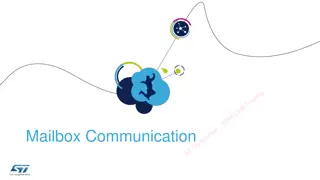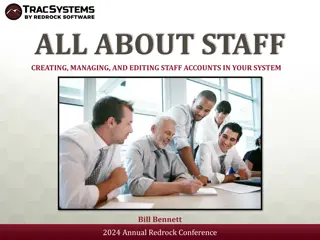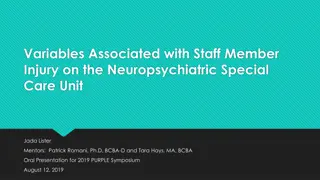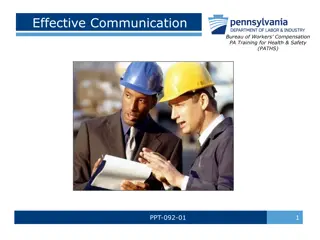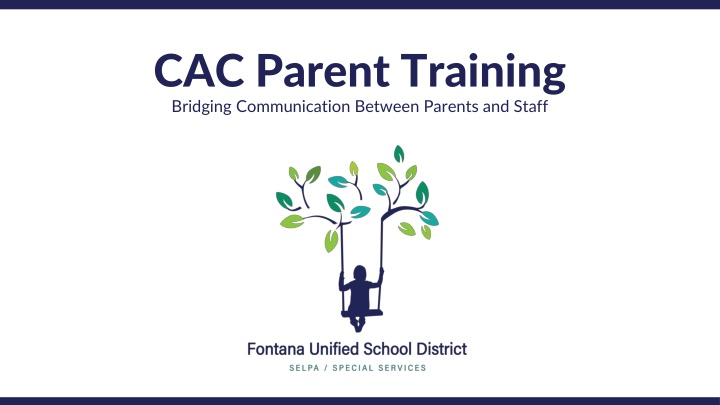
Effective Parent-Staff Communication Strategies
Discover the key elements of bridging communication between parents and staff in an educational setting. From the importance of parental involvement to fostering positive relationships and empowering families, this training covers active listening, collaborative problem-solving, and productive communication with the IEP team. Learn how to engage fully, be respectful of others, and be open to new ideas to enhance your partnership in education.
Download Presentation

Please find below an Image/Link to download the presentation.
The content on the website is provided AS IS for your information and personal use only. It may not be sold, licensed, or shared on other websites without obtaining consent from the author. If you encounter any issues during the download, it is possible that the publisher has removed the file from their server.
You are allowed to download the files provided on this website for personal or commercial use, subject to the condition that they are used lawfully. All files are the property of their respective owners.
The content on the website is provided AS IS for your information and personal use only. It may not be sold, licensed, or shared on other websites without obtaining consent from the author.
E N D
Presentation Transcript
CAC Parent Training Bridging Communication Between Parents and Staff
Lets Agree to 1. Engage fully 2. Be respectful of others 3. Be open to new ideas
Agenda Importance of Parental Involvement Active Listening to Encourage Collaboration Productive Communication with the IEP Team
Partners in Education: Systems of Support Collaborative Problem Solving Positive Relationships Multi- Dimensional Communications Empowering Families Data Based Goals & Outcomes Leadership
Partners in Education: Systems of Support Collaborative Problem Solving Positive Relationships Multi- Dimensional Communications Empowering Families Data Based Goals & Outcomes Leadership
Positive Relationships Get Involved in Schools Based in respect, transparency, and trust Be present as often as you can Be intentional and reach out to the school Share with school team your desires, dreams, and hopes for your student Encourage all family members to come and support with school events Build Relationships Take Opportunities to Help with Events
Partners in Education: Systems of Support Collaborative Problem Solving Positive Relationships Multi- Dimensional Communications Empowering Families Data Based Goals & Outcomes Leadership
Keep Asking Questions: Empower Families Tell me more about Encourage the engagement of other families to be involved with the school Why does this continue to happen Stay up to date with events at the school Get Site needs can change yearly What should I be asking involved in Parent Committees that I haven t asked about yet?
Partners in Education: Systems of Support Collaborative Problem Solving Positive Relationships Multi- Dimensional Communications Empowering Families Data Based Goals & Outcomes Leadership
Leadership Decision Making Advisory Committees Shared Vision
Partners in Education: Systems of Support Collaborative Problem Solving Positive Relationships Multi- Dimensional Communications Empowering Families Data Based Goals & Outcomes Leadership
Data Based Goals and Outcomes Help tell the story behind the data Story behind the numbers, as a parent you can add your voice to the story Participate in Surveys to help implement change Participate in surveys, the results from parent input can implement change Use data from surveys to guide improvement Families have a meaningful role in setting engagement goals
Partners in Education: Systems of Support Collaborative Problem Solving Positive Relationships Multi- Dimensional Communications Empowering Families Data Based Goals & Outcomes Leadership
Multi- Dimensional Communications Get Involved & Advocate More Support = More Involvement Face-to- Face Establishes a relationship Allows for increased follow up communications Call Email Text Tier 2 & Tier 3 levels of support tends to need more parental involvement Collaborate with teachers, school counselors, etc. May need to attend meetings to progress monitor student growth Use different methods to communicate as needed Shows your child school and relationships are important Methods of communication may vary based on family need
Partners in Education: Systems of Support Collaborative Problem Solving Positive Relationships Multi- Dimensional Communications Empowering Families Data Based Goals & Outcomes Leadership
Develop Trusting Connections Collaborative Problem Solving Parents and school staff work together to meet student needs Teachers cannot do it alone. We need parents so we can learn who your child is. You know your child best. Teachers need to know your children, so they are fully supported in the classroom. Share Information Work Toward a Shared Goal This person can help support you and may be able to achieve more student success through a collaborative effort Life events can impact student performance Collaboration with family and parents creates an honest dialogue Communicating with teacher, team can develop an action plan to solve instructional needs Team can focus on student success as the primary goal
Active Listening to Encourage Collaboration
Active Listening You cannot truly listen to anyone and do anything else at the same time. M. Scott Peck, author of The Road Less Traveled
Why Active Listening Works Active listening is a way of listening that involves full attention to what is being said for the primary purpose of understanding the speaker. It is an important skill set for many different circumstances, from personal to professional. If we are not listening actively, we are likely to miss the real message.
Active Listening When someone is conveying a message, there are two meanings to gather: the content and the feeling or attitude underlying the message. An active listener is not only tuned in to the information conveyed, but also how it is conveyed and any nonverbal cues present. Listen for Total Meaning Respond to Feelings After listening, when a response is appropriate, the listener should respond to the feeling of what was said. In this way, the speaker feels understood and empathy is established. Nonverbal cues include tone of voice, facial or body expressions, and speed of speech. All of these taken together can convey a much deeper meaning than merely the content of what was said. Note all Cues
Waterfall How do you know when you or someone else is engage in active listening? Type your answers in the chat, but DO NOT PRESS SEND! We will set the timer for 30 seconds. When timer is complete, press send, and everyone will see the waterfall responses for active listening.
Examples: Signs of Active Listening Body Language Building Trust and Rapport Tone of Voice Asking Open- Ended Questions Verbal Affirmations Shows Interest in Group Discussion
Techniques for Active Listening Technique Paraphrasing Purpose Convey interest Encourage the speaker to keep talking To Achieve It Restate the information just received with your own words Reflect the speaker s basic feeling and emotions in words Examples You showed up at the meeting on time. Verbalizing Emotions Show that you understand Help the speak to evaluate their own feelings And this made you really angry.
Techniques for Active Listening Technique Asking Purpose Get More information To Achieve It Ask questions Examples And after that, John did not react? These seem to be the key ideas you ve expressed. Summarizing Review progress Pull together important ideas Establish a basis for further discussion Restate major ideas expressed, including feelings
Techniques for Active Listening Technique Clarifying Purpose Clarify what is said Help the speaker see other points of view To Achieve It Ask questions for vague statements Restate wrong interpretations to force further explanation Examples You said that you reacted immediately. Was this still on the same day? Encouraging Convey interest Encourage the speaker to keep talking Disagree Use varying intonations Offer ideas and suggestions Then the student approached you. How did he behave?
Activity We will go into break out rooms. There will be two people in each group. Determine Partner A and Partner B. Partner B will describe their dream vacation. Describe in detail where you would like to vacation. Describe in 2 minutes. Partner A will guess where the dream location is from details from Partner B. Now switch roles for following the same directions. In 2 minutes, Partner B will guess Partner s A dream location.
Reflection Active listening is hearing and understanding, and then letting the other know that he or she is being heard and understood. It requires responding actively to another while keeping your attention focused completely on the speaker.
Productive Communication with the IEP Team
IEP Team Communication Put Stay Stay everything in writing Professional focused on the child
Which IEP Team Member Should You Contact? Case Manager The case manager is the Education Specialist that is assigned to your student. This person will communicate to all service providers, other teachers, administration, and with the family Site Administration Next steps when more support is required, contact the site administration SELPA Office Parental Rights and Procedural Safeguards Address concerns and Facilitate Resolution
The How of Effective IEP Communication IEP is the Focus Stick to the Facts Stay Child Focused Important Concerns Transparency Stick to the facts, not emotions Pertinent Information to inform with team members: medical diagnosis, medications, unusual behaviors, and/ or educational rights For important concerns, use the IEP process Keep focused on what your child is or isn t doing Evaluations, progress, strategies, etc. Do not assume intent Request evaluations formally in writing Focus on what happened and how it affected your child
The Where of IEP Communication Stay professional and respect boundaries. Use designated meetings or office hours. If you see teacher out in public, discourage discussing school matters outside of school. Keep a designated home/school communication log via email with teacher or binder. Parents have access to student information via Parent Square. Social media is not a place to discuss your student s IEP or frustrations with the team. Communicate with the team at school.
The When of the IEP Communication Communicate Student Needs Parent Teacher Conferences IEP Meetings Request to hold an IEP to discuss student placement, strategies, accommodations, etc. IEPs can be held before the next dated Annual Plan Review If you d like to discuss grades, a PTC can be held. Parent can meet with counselor to discuss credits Discussion with case carrier does not always warrant an IEP
Resources How to Effectively Communicate with your IEP Team by Lisa Lightner Family Engagement with Schools: Strategies to Build Strong Partnerships Active Listening Skills: Why Active Listening Is Important, And How To Do It . Psychology Today. June 2, 2020. By Dianne Grande, Ph.D. How to Practice Active Listening: 16 Examples and Techniques. PositivePsychology.com. February 8, 2022. By Amanda O'Bryan, Ph.D







